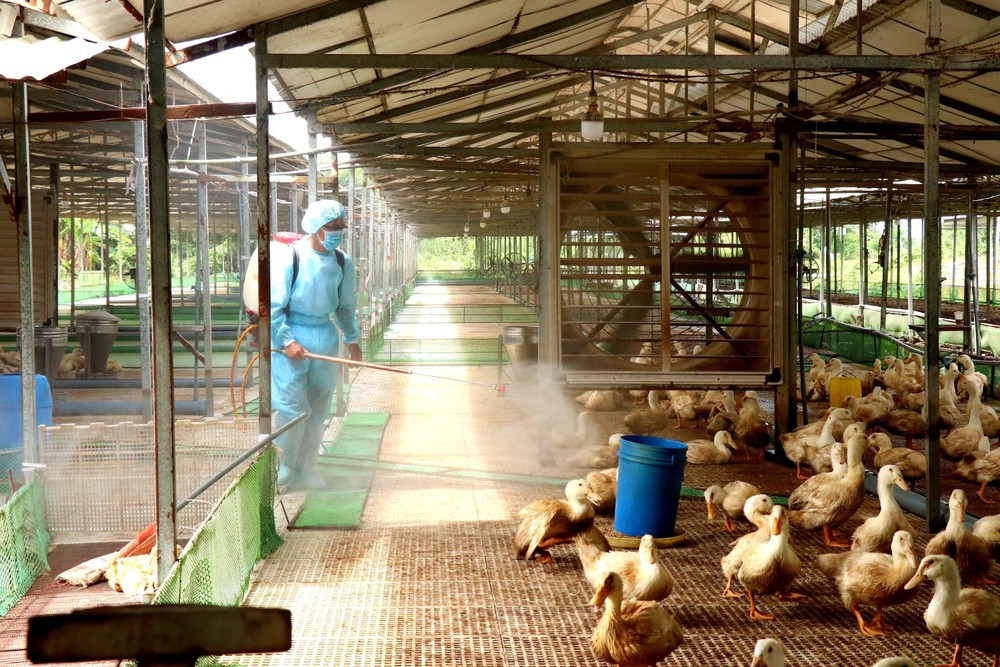According to the Department of Preventive Medicine, the failure to detect an outbreak of A/H9 influenza in poultry makes epidemiological surveillance, identification and containment of the outbreak difficult.

Last week, on April 6, Vietnam recorded its first human case of A/H9 influenza in Tien Giang. Currently, units are continuing to conduct in-depth tests to determine the virus subtype.
Experts from the Department of Preventive Medicine (Ministry of Health) emphasized that the current transitional season, unusual weather changes are favorable conditions for pathogens to develop, increasing interactions between influenza virus strains along with the risk of infection to mammals.
According to the US Centers for Disease Control and Prevention (US CDC), the A/H9N2 virus has been detected in bird populations in Asia, Europe, the Middle East, and Africa. Sporadic infections with the avian influenza A/H9N2 virus have been reported in humans with mild upper respiratory illness, although some infections have resulted in death.
There are 9 known subgroups of A/H9 virus: A/H9N1, A/H9N2, A/H9N3, A/H9N4, A/H9N5, A/H9N6, A/H9N7, A/H9N8, A/H9N9.
In Vietnam, the circulation of A/H5N1 influenza in humans has been confirmed before. With A/H9N2 influenza in the country recorded in poultry flocks, it can be transmitted to humans, but only the first case of A/H9 influenza in humans has just been announced as the first case.
Regarding the first human case of A/H9 influenza in Vietnam, according to the results of the epidemiological investigation, the patient's residence is located in a poultry market and poultry is traded in front of the patient's house; there have been no reports of sick or dead poultry around the area where the patient's family lives.
According to Dr. Nguyen Luong Tam - Deputy Director of the Department of Preventive Medicine (Ministry of Health), the failure to detect an outbreak of influenza A/H9 in poultry makes it difficult to monitor the epidemic, identify and isolate the outbreak, which may affect the implementation of disease control measures. On the other hand, because people and those who raise, trade, transport and slaughter poultry may subjectively think that poultry is healthy, they do not apply routine preventive measures such as wearing masks, gloves, washing hands... when in close contact, thereby increasing the risk of infection.
Mr. Nguyen Luong Tam said that many strains of influenza virus spread to humans, but mainly H5N1, H7N9 and H9N2. Recently, there has been an increase in cases of H9N2 bird flu infection in the world.

According to world medical literature, avian influenza strains with antigens H5, H7 and H9 can be transmitted to humans, of which the H5 strain is a highly pathogenic strain that often causes large outbreaks and mass deaths of poultry, causing severe symptoms and a very high mortality rate when transmitted to humans. The H7 and H9 strains are low pathogenic strains that often cause mild illness and rarely cause mass deaths of poultry. Combined with these strains are the N antigen subtypes from 1 to 9.
The combination and recombination of H and N antigens can create many types of avian influenza that infect humans. Currently, in some countries, avian influenza viruses have also been recorded in animals such as H5N1, H5N6, H5N8, H7N9, H9N2.
According to the World Health Organization, exposure to avian influenza viruses can cause infections ranging from mild flu-like symptoms or eye inflammation to severe acute respiratory illness or death. The severity of the illness depends on the type of virus causing the infection and the characteristics of the infected person.
Five types of avian influenza A viruses are known to cause infections in humans: H5, H6, H7, H9, and H10 viruses. The most frequently identified subtypes of avian influenza A viruses causing disease in humans are H5, H7, and H9 viruses. Specifically, A/H5N1 and A/H7N9 viruses have caused the majority of reported human cases of avian influenza A virus infection, with A/H5N6 and A/H9N2 viruses also causing human infections in recent years.
Since 2015, the Western Pacific region has recorded 98 cases of influenza A/H9N2 (including 2 deaths, both of which were patients with underlying diseases), of which 96 cases were recorded in China and 2 cases were recorded in Cambodia. Currently, there is no evidence that influenza A/H9N2 is transmitted from person to person.
In the world, from the end of 2023 until now, the situation of avian influenza in animals has been complicated, not only recording many outbreaks of avian influenza in all regions but also recording increasing transmission to mammals.
In the US, sporadic cases of A/H5N1 influenza infection from livestock have been recorded in many states. In Asia, outbreaks of avian influenza caused by many strains of A influenza virus such as H5N1, H5N6, H5N8, H3N2, H9N2, H10N3 continue to be recorded. Some countries bordering Vietnam continue to record human cases of avian influenza including H5N1, H9N2.
Therefore, the Department of Preventive Medicine recommends that people and those who raise, trade, transport, and slaughter poultry strictly comply with routine disease prevention measures when in close contact with poultry, when visiting high-risk areas such as markets or areas selling poultry and live animals.
There is currently no specific treatment or vaccine for avian influenza in humans. To proactively prevent the spread of avian influenza to humans, the Ministry of Health recommends that people take the following measures:
1. Do not eat sick, dead poultry or poultry products of unknown origin; ensure food is cooked and water is boiled; wash hands with soap before eating.
2. Do not slaughter, transport, buy or sell poultry and poultry products of unknown origin; limit contact with, slaughtering, and eating wild animals, especially birds.
3. When discovering sick or dead poultry, absolutely do not slaughter and use them, but immediately notify the local authorities and veterinary unit in the area.
4. Poultry breeders, traders, transporters and slaughterers must strictly comply with routine disease prevention measures;
5. It is recommended to wear a mask when entering a live poultry market or live poultry trading area; wash hands with soap after contact with poultry or after entering the market.
6. If you have flu-like symptoms such as fever, cough, chest pain, or difficulty breathing, go to a medical facility immediately for advice, examination, and timely treatment.